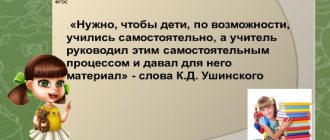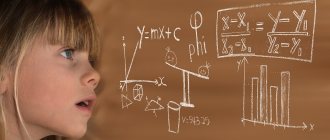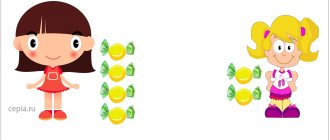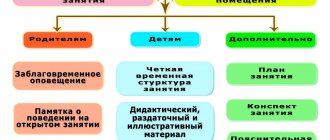Self-analysis of mathematics lessons
Introspection
Direct educational activities were carried out with children of the younger group, age from 2 to 3 years. There are 7 children. Duration 15 minutes.
Integration: GCD is built taking into account the integrative approach, which involves the implementation of the tasks of the educational areas “Speech development”, “Artistic and aesthetic development”, “Social and communicative development”, “physical development”.
When developing this outline of educational activities, I first of all took into account: the age, mental and individual characteristics of children in the younger group. Taking all this into account, I determined: goals, objectives, content, form of educational activities, methods, techniques and means necessary for positive results.
I was assigned the following tasks:
Educational: To foster interest in knowledge and research, independence, and activity.
Developmental: Continue to teach how to identify one object from many, answer the questions “how many”? in words one is many, not one. Strengthen the ability to compare objects large and small.
Educational: Teach children to combine identical (by color, size) objects into object sets according to a verbal task.
To successfully solve the identified problems, I prepared the following demonstration materials: a soft toy Bunny, large and small cubes, plates, circles of four colors. He helped me reveal the topic in a bright and interesting way.
To ensure children’s interest in the topic and emotional response to it, I created a problematic situation: “Our bunny loves to play and build towers: high and low. But I haven’t learned how to collect toys yet. And you and I are already big children, we have learned to play and put toys in their places. Let's help our bunny put the blocks into the boxes."
I used the following methods in my work:
Verbal - was used throughout all educational activities (when creating game motivation, when solving a problem situation)
Practical - when performing a problem situation (The Bunny brought cubes for each of you and asks you to put them in boxes: large cubes in a large box, and small ones in a small box).
The method of control and stimulation is in the form of approval and praise.
The methods used correspond to the material being studied and the ways of organizing children's activities in accordance with the level of the group.
The proposed tasks were given to children in a playful way, which contributed to the solution of the assigned development tasks: memory, imagination, attention.
Completing various game tasks created a positive, emotional background for the learning process, increased children’s speech activity and maintained interest throughout the entire educational activity.
Throughout the entire activity, the children were responsive, friendly and completed all tasks with great pleasure.
Analyzing the children’s activities, I would like to note that they showed cognitive activity, reacted emotionally, and used existing knowledge and skills. They were interested, attentive, organized. Encouraged indecisive and shy children to speak out.
Analyzing the educational activities carried out, we can say that the assigned tasks were successfully completed. I believe that the activities are structured logically, and the stages are interconnected.
Romanova Vitalina Anatolyevna, teacher,MBDOU DS No. 10 "Lazorik" of the city of Donetsk, Rostov region
Category "Work Experience"
Self-analysis of the lesson on FEMP “Journey through Mathematics”
Self-analysis of the lesson on FEMP “Journey through Mathematics”.
We have brought to your attention a lesson on the formation of elementary mathematical concepts in children of the preparatory group.
In my lesson, I set myself the following educational goals:
— Exercise children in forward, backward, ordinal counting.
— The composition of a number from two smaller ones, previous and subsequent numbers, which number is greater, less.
- Ability to make a sum from two smaller ones.
— Measuring length with a ruler.
— Solving a problem using numbers and signs with “-” and “+”.
— Develop logical thinking.
— Cultivate a desire to show acquired knowledge and interest in the lesson.
The children were told the topic of the lesson. The structure of the lesson corresponded to the assigned tasks. It is built in a logical sequence and interconnection of the parts of the lesson. The pace of the lesson is optimal. Speech rate is moderate. The material was presented emotionally. I selected the necessary visual aids and handouts.
When planning an open lesson, the age characteristics of the children were taken into account. The material is selected at a level accessible to children. Taking into account their age characteristics, the children answered the teacher’s questions, maintained a conversation, watched with interest, examined them, and willingly took on tasks. The children were quite active, felt comfortable, and willingly took part in the lesson.
All elements of an open lesson are united by a common theme. The content of the lesson corresponded to the goals set.
During the open lesson, the following working methods were used: verbal (questions, clarification, reminder, encouragement); visual demonstration (pictures and illustrations); game.
The main part of the lesson is aimed at the development of cognitive activity, the formation of mental and practical actions. Having set specific tasks for the children, she sought from each child (depending on his capabilities) their implementation, monitored the completion of tasks, made adjustments to their knowledge, provided the necessary assistance, and encouraged even minimal success. The volume of educational material ensured the children's activity and pace of work during the lesson. Its content corresponded to the purpose of the lesson, was scientific and at the same time accessible to children. To relieve general fatigue, a ball game was played.
The final part summarized the lesson.
I believe that the form of organizing classes for children that I chose was quite effective. I tried to comply with the norms of pedagogical ethics and tactics. I believe that the objectives set during the lesson were completed.
Self-analysis of direct educational activities on FEMP in the preparatory group
Elena Mambetova
Self-analysis of direct educational activities on FEMP in the preparatory group
Self-analysis of educational activities directly
on the formation of elementary mathematical concepts
in the preparatory group
Goal: developing interest in the subject of mathematics, based on cognitive activity and curiosity.
Tasks:
Educational . To promote the development of the ability to apply mathematical knowledge in non-standard practical problems.
Developmental. Develop mental operations: analogy, systematization, generalization, observation, planning.
Educational. Help maintain interest in mathematics and develop the ability to work in a team.
Integration of areas: socialization, communication, health, music, reading fiction.
Preliminary work:
Guessing riddles, solving logical problems, solving simple arithmetic problems, observing the calendar, individual lessons Learning physics. a minute, board games
Organization of direct educational activities (EDA)
Educational activities were carried out in the preparatory group and lasted 30 minutes.
All sanitary and hygienic requirements were met: furniture was selected To create interest, the children went on a rocket trip to the planet Mathematics, where they completed various mathematical tasks. Directly educational activities were built in a single game plot.
Changing types of activities (game, communicative, motor)
contributed to maintaining the attention and performance of children throughout their educational activities
. Physical education was used during the activity
, visual and finger gymnastics.
Structure of direct educational activities (DEA)
In its structure, the educational activity itself is designed in such a way as to arouse and maintain interest in the subject of mathematics, based on cognitive activity and curiosity.
The first part included an organizational point: preparing for the trip . to stimulate auditory attention and perception, motivation.
The second part consisted of unique stages - completing tasks: guessing riddles, “What is extra and why?”
“Name the intended number” “Remember and do”
is an exercise for the development of auditory perception, which helped maintain the attention and performance of children throughout their
educational activities .
The third part is the result, reflection.
Teaching methods and techniques
Methods and principles are selected in accordance with educational , developmental and educational objectives.
In the course of direct educational activities, visual, verbal and practical, game methods were used, aimed at the use of cognitive, speech, motor, practical skills and abilities, and their improvement.
The proposed games were selected according to the age of the children, which contributed to the solution of the assigned tasks.
Throughout the entire activity , cognitive interest was maintained using surprise moments and games.
In the process of educational activities, educational goals were also pursued: to cultivate interest in mathematics, to develop the ability to work in a team.
Various ways of including children in the educational process : intonation of speech, emotional expressiveness.
In the process of direct educational activities, work was continuously carried out to expand and enrich the vocabulary of children.
GCD effectiveness
I believe that the set goal and objectives have been achieved.






